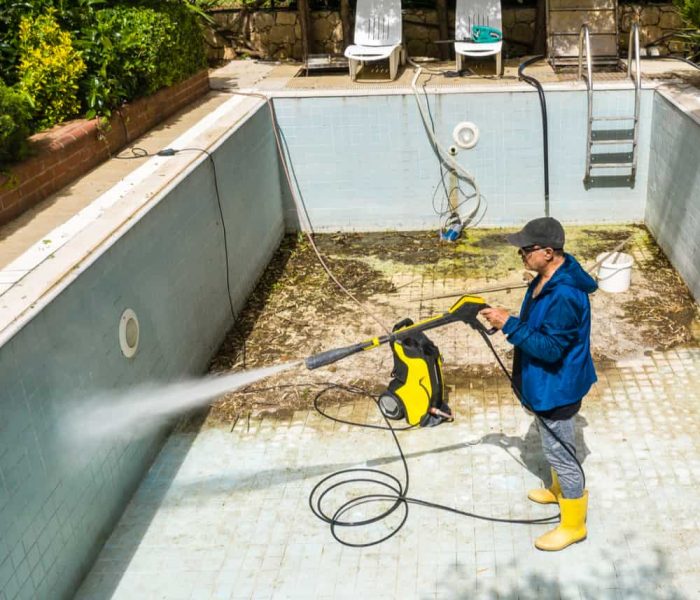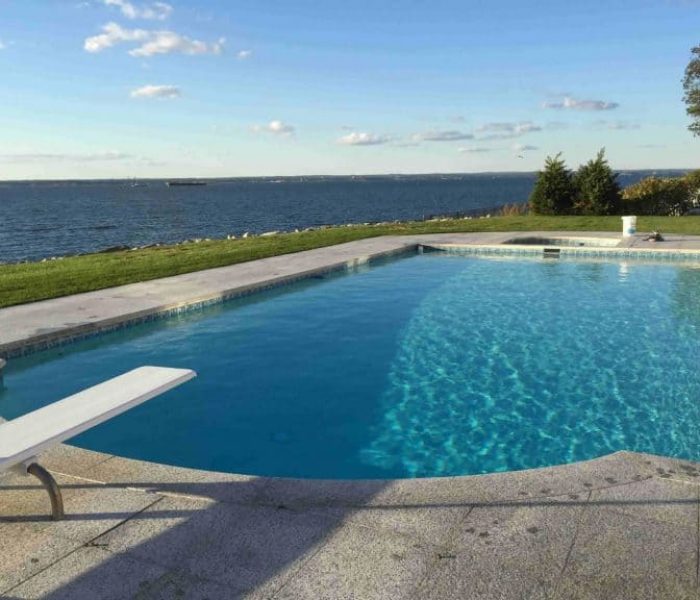Get Started By Contacting us!
When the residents of Suffolk County are in need of pool liner replacement services, there’s only one place they call: JAS Aquatics! Since 2009, our locally owned and operated, fully licensed and insured Fire Island, NY pool company has been providing the homeowners of New York with a full suite of pool services, including pool liner replacements. Our team of professionally trained and highly experienced technicians will expertly replace your pool liner, improving the visual appeal and extending the life of your backyard swimming pool. For expert pool liner replacement services, look no further than JAS Aquatics!
4 Signs You Need to Contact a Fire Island, NY Pool Liner Replacement Company
With proper maintenance, a pool liner can last anywhere from 10 to 20 years; however, there are several factors that can negatively impact and reduce the lifespan of a liner, such as the frequency of use, severe weather, and neglect. With that said, eventually, you’re going to need to invest in pool liner replacement services at some point.
How can you tell when you need to replace your Suffolk County swimming pool liner? From leaks to fading, here’s a look at some telltale signs that it’s time to get in touch with a Fire Island, NY pool company to get a quote for a liner replacement.
Tearing or Cracking
Frequent use, chemical exposure, and the harsh UV rays of the sun can weaken and cause cracks and tears in a swimming pool liner. If you see any evidence of cracks or tears along the bottom or on the walls of your swimming pool, get in touch with a Fire Island, NY pool company. Depending on the extent of the damage, swimming pool replacement companies may be able to repair the cracks and tears; however, if the damage is severe, you’ll need a pool liner replacement.
Leaks
If the water level in your Suffolk County pool seems significantly low, something is amiss. If it’s been extremely hot and dry for a prolonged period of time, it may just be that some of the water has evaporated, in which case you should be able to just fill the pool back up. If, however, the water seems to be low shortly after you’ve refilled your inground pool, that’s a sign you have a leak, and swimming pool liner replacement may be necessary. A reputable Fire Island, NY pool company will perform a thorough inspection to determine the cause of the problem and will offer solutions to remedy the issue.
It’s Faded
Regular exposure to the UV rays of the sun and/or chemicals, such as high concentrations of chlorine, can cause a swimming pool liner to fade. Typically, fading is merely an aesthetics issue and a pool liner replacement will help to give your Suffolk County yard a fresh look. That said, however, depending on the extent of the problem, the spots where the fading has occurred may weaken the liner, which could increase the risk of more serious issues down the road, such as leaks.
It’s Slipped Out of the Coping Track
As a pool liner ages, it will stretches, and as that happens, it can start slipping out of the coping track. Also referred to as a “liner pull”, it’s a telltale sign that your swimming pool liner has reached the end of its life. If you fail to address the problem, the coping can become damaged, and more extensive and costly repairs will be needed, so as soon as you notice the liner is slipping, get in touch with a Fire Island, NY pool company.
If you’re in need of pool liner replacement services, contact the Fire Island, NY pool company Suffolk County trusts most: JAS Aquatics! Our team of experts will perform a thorough assessment of your swimming pool liner and will quickly and efficiently replace it, enhancing the durability and restoring the aesthetic appeal of your backyard swimming pool. To learn more or to request a free price quote, call 631-239-8031 and one of our knowledgeable and friendly associates will be happy to assist you with all of your needs.


Fire Island is the large center island of the outer barrier islands parallel to the south shore of Long Island, New York.
Though it is well established that indigenous Native Americans occupied what are today known as Long Island and Fire Island for many centuries before Europeans arrived, there has existed a long-standing myth that Long Island and nearby Fire Island were occupied by “thirteen tribes” “neatly divided into thirteen tribal units, beginning with the Canarsie who lived in present-day Brooklyn and ending with the Montauk on the far eastern end of the island.” Modern ethnographic research indicates, however, that before the European invasion, Long Island and Fire Island were occupied by “indigenous groups […] organized into village systems with varying levels of social complexity. They lived in small communities that were connected in an intricate web of kinship relations […] there were probably no native peoples living in tribal systems on Long Island until after the Europeans arrived. […] The communities appear to have been divided into two general culture areas that overlapped in the area known today as the Hempstead Plains […]. The western groups spoke the Delaware-Munsee dialect of Algonquian and shared cultural characteristics such as the longhouse system of social organization with their brethren in what is now New Jersey and Delaware. The linguistic affiliation of the eastern groups is less well understood […] Goddard […] concluded that the languages here are related to the southern New England Algonquian dialects, but he could only speculate on the nature of these relationships […]. Working with a few brief vocabulary lists of Montauk and Unquachog, he suggested that the Montauk might be related to Mohegan-Pequot and the Unquachog might possibly be grouped with the Quiripi of western Connecticut. The information on the Shinnecock was too sparse for any determination […] The most common pattern of indigenous life on Long Island prior to the intervention of the whites was the autonomous village linked by kinship to its neighbors.”
“Most of the ‘tribal’ names with which we are now familiar do not appear to have been recognized by either the first European observers or by the original inhabitants until the process of land purchases began after the first settlements were established. We simply do not know what these people called themselves, but all the ethnographic data on North American Indian cultures suggest that they identified themselves in terms of lineage and clan membership. […] The English and Dutch were frustrated by this lack of structure because it made land purchase so difficult. Deeds, according to the European concept of property, had to be signed by identifiable owners with authority to sell and have specific boundaries on a map. The relatively amorphous leadership structure of the Long Island communities, the imprecise delineation of hunting ground boundaries, and their view of the land as a living entity to be used rather than owned made conventional European real estate deals nearly impossible to negotiate. The surviving primary records suggest that the Dutch and English remedied this situation by pressing cooperative local sachems to establish a more structured political base in their communities and to define their communities as “tribes” with specific boundaries […] The Montauk, under the leadership of Wyandanch in the mid-seventeenth century, and the Matinnecock, under the sachems Suscaneman and Tackapousha, do appear to have developed rather tenuous coalitions as a result of their contact with the English settlers.”
“An early example of [European] intervention into Native American political institutions is a 1664 agreement wherein the East Hampton and Southampton officials appointed a sunk squaw named Quashawam to govern both the Shinnecock and the Montauk.”
Learn more about Fire Island.


Ready to make a splash with your new pool project? Contact Jas Aquatics today to share your dream pool vision. We’re committed to transforming your ideas into a stunning reality with our professional expertise in pool design and installation. Reach out now to begin a conversation that leads to your ideal aquatic escape.